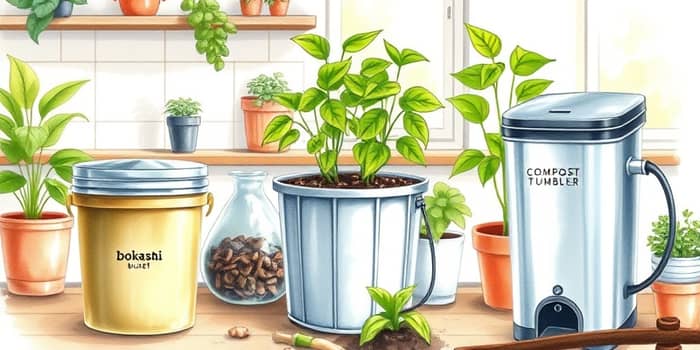Transforming kitchen scraps into nutrient-rich soil can feel intimidating when you worry about odors, pests, or clutter. Yet, with the right approach and tools, anyone can explore the art of home composting and reap countless rewards.
Why Composting Matters
Composting is more than a gardening hack; it’s a powerful way to close the nutrient loop, reducing landfill waste and nurturing soil health. By diverting food waste from garbage bins, you can cut household waste by up to 30% and produce your own fertilizer.
Across urban and rural settings, gardeners and plant lovers embrace innovative home composting solutions that enrich houseplants, balcony gardens, and community plots. Every peel, shell, and coffee ground can become part of a living ecosystem.
Overcoming Common Barriers
Many hesitate to compost at home due to fears of stench, pests, or limited space. The good news is that modern systems tackle these concerns head-on.
- Odor: Traditional piles can stink, but sealed systems prevent smells completely.
- Pests: Containers designed with tight lids or filters keep rodents and insects away.
- Space constraints: Compact units fit under sinks, on balconies, or beside countertops.
- Mess worries: Specialized bins and crocks ensure no spills or leaks.
Popular Odorless and Mess-Free Composting Methods
Whether you live in a studio apartment or a suburban home, you can find odor- and mess-free composting options to suit your lifestyle.
Bokashi fermenting uses a tightly sealed bucket for fermentation that processes almost all food waste, even dairy and meat, without any smell. Drain the nutrient-rich “bokashi tea” weekly and bury the pre-compost in soil.
Worm composting relies on composting worms and organic bedding to break down scraps into rich vermicompost. A small bin kept at 59–77°F under a countertop yields plant-ready soil amendment in just weeks.
Compost tumblers feature a rotating drum accelerates decomposition by aerating materials at each turn. With a sealed design, you won’t attract pests or notice odors, and a two-square-foot unit can handle 37 gallons per batch.
Indoor soil-based composters are a compact self-contained compost system that layers soil, microbes, and scraps. Fits neatly under a sink and produces 2–3 pounds of compost monthly for houseplants or balcony pots.
Compost crocks coupled with freezer storage use a charcoal-filtered scrap collection crock for daily scraps. Freeze food waste to pause decomposition, then transfer every few days to your main system or community drop-off.
Electric food waste processors incorporate multi-layer odor control filters to handle all food types, grinding and dehydrating waste into fine material within hours. Filters cost between $35 and $220 per year, depending on the model.
Trench or sheet composting lets you bury scraps directly in garden beds with direct burial in garden beds or layer materials under mulch. This natural approach protects against pests and integrates nutrients over months.
Tips for a Fresh, Clean Compost
Keep your compost system efficient and odor-free by following a few simple practices.
- Balance greens and browns: aim for roughly equal volumes of nitrogen-rich and carbon-rich materials.
- Maintain proper moisture: the mix should feel like a damp sponge, not drenched.
- Seal collection bins and add charcoal filters to absorb lingering smells.
- Aerate frequently: turn tumblers every 2–3 days, or stir soil-based systems weekly.
- Freeze or refrigerate scraps if you can’t transfer them immediately.
- Bury fresh waste under bedding or soil to deter flies and odors.
Getting Started with Your Mess-Free Compost
Embarking on your composting journey is easier than you think. Here’s a simple roadmap to success.
- Choose your method: select a system that matches your space, budget, and lifestyle.
- Gather supplies: bins, worms, bokashi bran, filters, or an electric processor—whatever suits your plan.
- Learn the basics: understand the balance of greens and browns, temperature ranges, and moisture levels.
- Start small: add scraps gradually to prevent overload and monitor how your system responds.
- Nurture your compost: maintain air flow, occasional turning, and proper moisture for optimal breakdown.
Troubleshooting Common Issues
If you detect odors, check moisture first. A soggy bin signals excess nitrogen—add dry browns like shredded paper or leaves. For persistent smells, seal the collection crock and replace charcoal filters more often.
Pest invasions usually mean scraps are exposed. Always cover new material with bedding or soil, and ensure your container lids lock securely. Freezing scraps can also deter fruit flies.
If composting slows down, confirm temperature and moisture levels. Worm composters thrive at 59–77°F, while electric processors need occasional cleaning of blades and vents. Adding fresh bran to bokashi bins reactivates microbial action.
Conclusion
Composting at home doesn’t have to be messy or smelly. By choosing the right method, applying simple maintenance tips, and embracing transform kitchen scraps into living soil, you can turn everyday waste into a garden’s gold. Start small, stay consistent, and watch your compost—and your plants—flourish.
References
- https://www.farmstandapp.com/59981/6-alternative-methods-for-composting-in-small-spaces/
- https://foodgardening.mequoda.com/daily/composting/how-to-keep-an-odor-free-compost-bin-in-your-home/
- https://www.epa.gov/recycle/composting-home
- https://readingmytealeaves.com/2020/06/make-your-own-indoor-compost-bin-hiroko-tabuchi-odorless-compost-at-home.html
- https://reencle.co/products/reencle-food-waste-composter
- https://www.farmstandapp.com/65692/7-indoor-composting-techniques-for-apartments/
- https://extension.umd.edu/resource/how-make-compost-home
- https://theecoguide.org/lazy-composting










